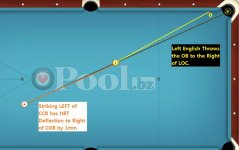This topic came up on another thread, but I thought it deserved it's own thread. http://forums.azbilliards.com/showthread.php?t=315283&page=3
One doesn't need to be a user of BHE to benefit from using knowledge their cue's pivot point and the effective pivot point, or squerve point for various shots.
When a player strikes a CB left or right of their intended aim on the CB, they are effectively pivoting, when the movement isn't due to a shifting of the bridge hand. They are basically playing unintentional BHE.
We can use this to significantly increase our margin of stroking error in a couple of ways for different types of shots.
On a straightish shot, getting unintended left of right english can throw the OB significantly off path. Also, the off center hitting can change the direction the CB takes.
Hitting left of the CB does NOT however tell us what the resultant path of the CB will be. This depends upon the length of bridge the player is using and how this corresponds to the effective pivot point of the shot.
A short bridge will deflect the CB to the left and a long bridge will deflect it to the right.
Some magic occurs if the bridge is just a little longer than the effective pivot point on a 7/8ths to straight shots. There is a bridge length for these shots, which varies according to the separation of CB and OB, where the CB deflection is perfectly cancelled out by the unintended spin induced throw.
While it's difficult to determine the exact bridge length to achieve this, we can get close enough to significantly increase our margin for stroking error on these shots.
In the case of finer cut shots, the variability in throw for a touch of inside versus a touch of outside is less extreme, so to maximize our margin for error in the case of striking the CB unintentionally off center, bridging AT the effective pivot point, and not an inch or two behind it, is most effective.
So one doesn't need to be a proponent of BHE to use knowledge of Pivot Points and throw to their advantage to reduce the margin for error due to wonky stroking.
Colin
One doesn't need to be a user of BHE to benefit from using knowledge their cue's pivot point and the effective pivot point, or squerve point for various shots.
When a player strikes a CB left or right of their intended aim on the CB, they are effectively pivoting, when the movement isn't due to a shifting of the bridge hand. They are basically playing unintentional BHE.
We can use this to significantly increase our margin of stroking error in a couple of ways for different types of shots.
On a straightish shot, getting unintended left of right english can throw the OB significantly off path. Also, the off center hitting can change the direction the CB takes.
Hitting left of the CB does NOT however tell us what the resultant path of the CB will be. This depends upon the length of bridge the player is using and how this corresponds to the effective pivot point of the shot.
A short bridge will deflect the CB to the left and a long bridge will deflect it to the right.
Some magic occurs if the bridge is just a little longer than the effective pivot point on a 7/8ths to straight shots. There is a bridge length for these shots, which varies according to the separation of CB and OB, where the CB deflection is perfectly cancelled out by the unintended spin induced throw.
While it's difficult to determine the exact bridge length to achieve this, we can get close enough to significantly increase our margin for stroking error on these shots.
In the case of finer cut shots, the variability in throw for a touch of inside versus a touch of outside is less extreme, so to maximize our margin for error in the case of striking the CB unintentionally off center, bridging AT the effective pivot point, and not an inch or two behind it, is most effective.
So one doesn't need to be a proponent of BHE to use knowledge of Pivot Points and throw to their advantage to reduce the margin for error due to wonky stroking.
Colin
